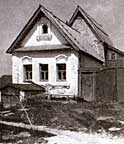| Виртуальный Владимир » Город Владимир » Old Russian Towns » Suzdal » Historic buildings » 17th century house |
 ...
... On the way to the Cathedral of the Nativity
On the way to the Cathedral of the Nativity Cathedral of the Nativity
Cathedral of the Nativity Archbishops palace and bell-tower
Archbishops palace and bell-tower Church of St. Nicholas
Church of St. Nicholas Church oi St. Boris and St. Gleb
Church oi St. Boris and St. Gleb Monastery of St. Dmitri
Monastery of St. Dmitri Church of St. Nicholas
Church of St. Nicholas Church of St. Cosmas and St. Damian
Church of St. Cosmas and St. Damian Church of the Sign
Church of the Sign market place
market place Church of John the Baptist
Church of John the Baptist Church of the Entry into Jerusalem
Church of the Entry into Jerusalem Gostiny Dvor
Gostiny Dvor Church of the Resurrection
Church of the Resurrection Church oi the Emperor Constantino
Church oi the Emperor Constantino Church of St. Lazarus
Church of St. Lazarus Convent of the Deposition of the Robe
Convent of the Deposition of the Robe Holy Gates
Holy Gates Cathedral of the Deposition of the Robe
Cathedral of the Deposition of the Robe Trinity Cathedral
Trinity Cathedral Monastery of St. Alexander
Monastery of St. Alexander brick kiln
brick kiln Church of Tanners Settlement
Church of Tanners Settlement Church of Our Lady of Tikhvin
Church of Our Lady of Tikhvin Church of St. Peter and St. Paul
Church of St. Peter and St. Paul Convent ot the Intercession
Convent ot the Intercession Church of the Conception
Church of the Conception Spaso-Yevfimiev Monastery
Spaso-Yevfimiev Monastery Cathedral oi the Transfiguration
Cathedral oi the Transfiguration Church of Our Lady of Smolensk
Church of Our Lady of Smolensk 17th century house
17th century house Monastery of St. Basil
Monastery of St. Basil Yuri Dolgorukys castle
Yuri Dolgorukys castle Church oi St. Boris and St. Gleb
Church oi St. Boris and St. Gleb Nearby is a well-preserved specimen of seventeenth-century domestic architecture now No. 134 Lenin Street (Ulitsa Lenina). It was obviously the property of a wealthy citizen or member of the clergy and may have belonged to the Suzdal priest, Nikita Pusto-svyat, one of the Old Believers. An early nineteenth-century painting of Suzdal shows a similar house by the Cathedral of the Nativity in the kremlin. Although the house is built of brick everything about it shows the influence of traditional wooden architecture. It consists of two square frames of different heights each covered with a saddleback roof and resembles the church from Glo-tovo which we saw in the kremlin. The larger, eastern section has two storeys, the lower one used for storage and such like with a vaulted ceiling which has survived. This large section is made of brick and is adjoined by a, smaller section with three attractive windows on the front wall. The windows have since been widened and given new surrounds. Houses of this kind stood out sharply against the humble wooden dwellings of the ordinary townspeople. This rare specimen of domestic architecture helps us to understand why we find traces of the devices and forms characteristic of wooden buildings in church architecture of the seventeenth and eighteenth century, and why the churches of this period possess features which make them resemble ordinary dwellings, as we have mentioned on several occasions earlier. These tendencies reflect the tastes of the townspeople who were beginning to play an increasingly important role in society, which explains the gradual but clearly perceptible process of the secularisation of church architecture.
Nearby is a well-preserved specimen of seventeenth-century domestic architecture now No. 134 Lenin Street (Ulitsa Lenina). It was obviously the property of a wealthy citizen or member of the clergy and may have belonged to the Suzdal priest, Nikita Pusto-svyat, one of the Old Believers. An early nineteenth-century painting of Suzdal shows a similar house by the Cathedral of the Nativity in the kremlin. Although the house is built of brick everything about it shows the influence of traditional wooden architecture. It consists of two square frames of different heights each covered with a saddleback roof and resembles the church from Glo-tovo which we saw in the kremlin. The larger, eastern section has two storeys, the lower one used for storage and such like with a vaulted ceiling which has survived. This large section is made of brick and is adjoined by a, smaller section with three attractive windows on the front wall. The windows have since been widened and given new surrounds. Houses of this kind stood out sharply against the humble wooden dwellings of the ordinary townspeople. This rare specimen of domestic architecture helps us to understand why we find traces of the devices and forms characteristic of wooden buildings in church architecture of the seventeenth and eighteenth century, and why the churches of this period possess features which make them resemble ordinary dwellings, as we have mentioned on several occasions earlier. These tendencies reflect the tastes of the townspeople who were beginning to play an increasingly important role in society, which explains the gradual but clearly perceptible process of the secularisation of church architecture.
Оставить комментарий:



 Виртуальный Владимир
Виртуальный Владимир Область
Область Панорамы города
Панорамы города Организации
Организации Улицы и дома
Улицы и дома Добавить организацию
Добавить организацию О городе
О городе










